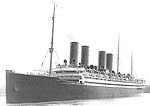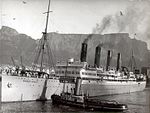Four-funnel liner

This article needs additional citations for verification. (January 2019) |

A four-funnel liner, also known as a four-stacker, is an ocean liner with four funnels.
Kaiser Wilhelm der Grosse, launched in 1897, was the first ocean liner to have four funnels and was one of the first of the golden era of ocean liners that became prominent in the 20th century.[1]
Among the most well known four-funnels are Titanic, sunk on her maiden voyage on 15 April 1912, and Lusitania, torpedoed on 7 May 1915, during the First World War. In all, 15 four-funnel liners were produced; Great Eastern in 1858, and the remainder between 1897 and 1922. Four were sunk during the World Wars, and all others besides Titanic were scrapped.[2]
Mauretania was the fastest of all four-funnelled liners. The last four-funnelled liner ever built was Windsor Castle; however, two of her funnels were later removed making the Aquitania the last four-funnel liner in service and the only one to survive service during both World Wars.
Description
[edit]Rise of the four-funnel liner
[edit]The primary purpose of funnels on steamships was to allow smoke, heat and excess steam to escape from the boiler rooms. As liners became larger, more boilers were used. The number of funnels became symbolic of speed and safety,[1] so shipping companies sometimes added false funnels—like the Olympic-class ocean liners—to give an impression of power.[3]
Great Eastern, launched on 31 January 1858 (a full 40 years ahead of any comparable ships), was the only ocean liner to sport five funnels. As one funnel was later removed in 1865,[4] Great Eastern, by default, became the first ocean liner to have four funnels. However, she was converted to a cable-laying vessel not long afterwards and never operated as a liner when she only had four funnels.
Kaiser Wilhelm der Grosse, launched on 4 May 1897, was the first purpose-built ocean liner to have four funnels and was one of the first of the golden era of ocean liners that became prominent in the early- to mid-20th century.[1] The trend of competing shipping lines building four-funnel liners encompassed a very short time span ranging from the SS Kaiser Wilhelm der Grosse in 1897 to the RMS Windsor Castle in 1922.[5]
The Cunard Line record holders, Lusitania and Mauretania, were both laid out with four boiler rooms with one funnel to each room.
In keeping with the style and fashion of the early-20th century, the White Star Line opted to fit the three Olympic-class ships with a dummy fourth funnel to rival the two Cunard ships.
End of the four-funnel liner
[edit]The ideology of four funnels representing size and power rapidly diminished soon after the First World War. Subsequent flagships including the SS Imperator, SS Normandie, and RMS Queen Mary all sported three funnels to conserve deck space. Later, as shipbuilding became more efficient, RMS Queen Elizabeth, Mauretania, Bremen, Nieuw Amsterdam, and America further reduced the number of funnels down to two. Today's modern cruise ships are mostly built with only a single funnel, and many military vessels no longer sport them at all.
Soon, the remaining four-funnel liners seemed old. The first four-funnel liner to go was the Titanic when she sank in 1912 after hitting an iceberg.[6] During the First World War, Kaiser Wilhelm der Grosse, Lusitania, and Britannic sank after being attacked by enemy vessels (with Britannic striking a mine).[7] The last four-funnel liners built were the sister ships Arundel Castle and Windsor Castle which entered service in 1921. By 1922, only 10 of the 14 four-funnel liners remained. In 1923, the ex-Kronprinz Wilhelm was sold for scrap, followed by the ex-Deutschland in 1925.[8]
By the start of the Great Depression, only 8 four-funnel liners remained. In 1935, the Mauretania, Olympic and France were sold for scrap after 28, 24, and 23 years of service respectively. In 1937, the Arundel Castle and Windsor Castle were refurbished by having two of their four funnels removed and their bows replaced by more raked bows,[9] leaving the Kaiser Wilhelm II, Kronprinzessin Cecilie and Aquitania as the three remaining four-funnel liners.[10] In 1940, the ex-Kaiser Wilhelm II and ex-Kronprinzessin Cecilie were sold for scrap. The Aquitania, now the last four-funnel liner afloat, served in the Second World War and thereafter enjoyed a quiet postwar career, until finally she was scrapped in 1950. With this, the era of the four-funnel liner came to an end.[11]
List of four funnel liners
[edit]| Picture | Liner[a] | Owner | Launched | Fate |
|---|---|---|---|---|
 | RMS Aquitania[2] | Cunard Line | 1913, April 21 | scrapped 1950 |
 | RMS Arundel Castle[b][2] | Union-Castle Line | 1919, September 11 | scrapped 1959 |
 | HMHS Britannic[c][2] | White Star Line | 1914, February 26 | sunk 21 November 1916 |
 | SS Deutschland[b][2] | Hamburg-Amerika Line | 1900, January 10 | scrapped 1925 |
 | SS France[2] | Compagnie Générale Transatlantique | 1910, September 10 | scrapped 1935 |
 | SS Kaiser Wilhelm II[d][2] | North German Lloyd Line | 1902, August 12 | scrapped 1940 |
 | SS Kaiser Wilhelm der Grosse[d][2] | North German Lloyd Line | 1897, May 4 | sunk 26 August 1914; wreck dismantled on site in 1952 |
 | SS Kronprinz Wilhelm[d][2] | North German Lloyd Line | 1901, March 30 | scrapped 1923 |
 | SS Kronprinzessin Cecilie[d][2] | North German Lloyd Line | 1906, December 1 | scrapped 1940 |
 | RMS Lusitania[2] | Cunard Line | 1906, June 7 | sunk 7 May 1915 |
 | RMS Mauretania[2] | Cunard Line | 1906, September 20 | scrapped 1935 |
 | RMS Olympic[c][2] | White Star Line | 1910, October 20 | scrapped 1935–37 |
 | RMS Titanic[c][2] | White Star Line | 1911, May 31 | Sank 15 April 1912 |
 | RMS Windsor Castle[b][2] | Union-Castle Line | 1921, March 9 | sunk 23 March 1943 |
Notes:
- ^ SS denotes 'Steamship', RMS denotes 'Royal Mail Ship', HMHS denotes 'His/Her Majesty's Hospital Ship'
- ^ a b c Originally constructed with four funnels, two were removed during later modernisation.
- ^ a b c The aft funnel on each of the White Star Olympic-class liners were dummies.[12]
- ^ a b c d The group Kaiser-class[1] four funnel liners owned by North German Lloyd Lines were called the Four Flyers.[13]
Proposed ships
[edit]The United States never operated any four-funnelled ocean liners in commercial service. However, in the late 1910s, William Francis Gibbs began to draft designs for new 1,000-foot liners that could reach a speed of 30 knots. Among the proposals was a pair of four-funnelled ships designed in 1919. The funnel and boiler arrangement would have been similar to the German four stackers, with the four funnels grouped in pairs with a wider gap between the second and third funnels. Possible names for the liners were the SS Boston and the SS Independence. The ships never made it past the design phase.[14]
In the late 1920s Britain's White Star Line placed an order to the shipbuilder Harland and Wolff for Oceanic, which would have been the third ship in White Star's history to bear that name. The exact intended design of Oceanic III is unknown, although company concept renderings show it to be a three-funnelled 1,000-foot (300 m) liner. However, early plans from Harland and Wolff's archives show a design from 1927 for a four-funnelled liner almost identical to the Olympic-class, except with a more-modern cruiser stern.[ambiguous][15] Construction of Oceanic III halted in mid-1929, before the onset of the Great Depression led to its cancellation.
References
[edit]- ^ a b c d Ljungström, Henrik. "Kaiser Wilhelm der Grosse". The Great Ocean Liners. Archived from the original on 10 October 2009. Retrieved 8 September 2008.
- ^ a b c d e f g h i j k l m n o Pocock, Michael. "The Four-Funnel Liners". Retrieved 8 September 2008.
- ^ "Titanic Station: Titanic's Funnels, or Smokestacks". Titanicstation.blogspot.com. 21 May 2007. Retrieved 5 July 2011.
- ^ "History of the Atlantic Cable & Submarine Telegraphy - Great Eastern". Atlantic-cable.com. Retrieved 2011-07-05.
- ^ "Kaiser Wilhelm der Grosse – TGOL".
- ^ "Titanic – TGOL".
- ^ King, Greg and Wilson, Penny (2015). Lusitania: Triumph, Tragedy and the End of the Edwardian Age. p. 273
- ^ "Deutschland – TGOL".
- ^ Smith, Edgar C. (2013) [1937]. A Short History of Naval and Marine Engineering. p. 315. ISBN 978-1107672932.
- ^ "Atlantic Liners Book". www.atlanticliners.com. Archived from the original on 25 February 2007. Retrieved 12 January 2022.
- ^ "Aquitania – TGOL".
- ^ The 4 funnel liners. "The 4 funnel liners". Allatsea.co.za. Archived from the original on 2011-09-27. Retrieved 2011-07-05.
{{cite web}}: CS1 maint: numeric names: authors list (link) - ^ Ljungström, Henrik. "Kronprinzessin Cecilie". The Great Ocean Liners. Retrieved 2008-09-08. [dead link]
- ^ "Image 7 of the New York times (New-York [N.Y.]), August 3, 1919". Library of Congress.
- ^ four-funnel liner plans, Harland and Wolff 1927 at titanichistoricalsociety.net. Archived 2011-07-24 at the Wayback Machine
External links
[edit] Media related to Four-funnel liners at Wikimedia Commons
Media related to Four-funnel liners at Wikimedia Commons